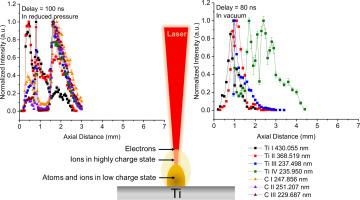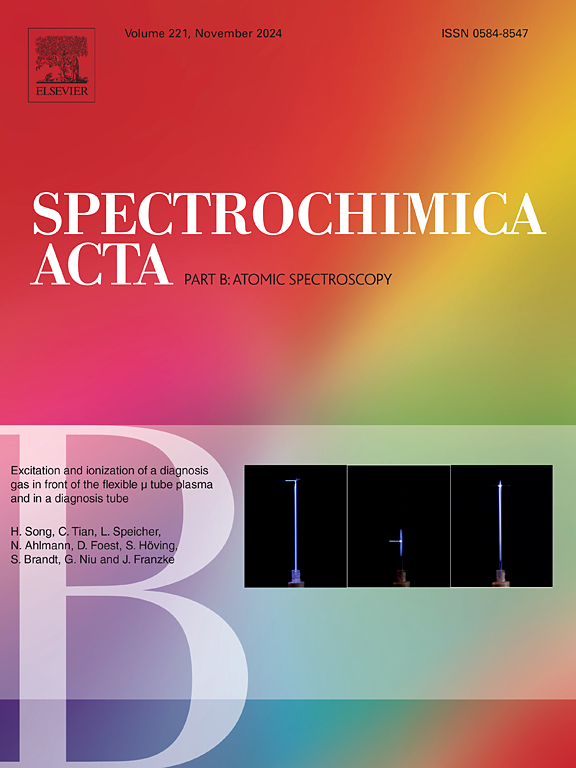离子加速对减压和真空环境下LIBS的影响
IF 3.8
2区 化学
Q1 SPECTROSCOPY
引用次数: 0
摘要
随着LIBS在深空探测中的重要应用,在火星等减压环境和月球、托卡马克等真空环境下对激光等离子体进行表征,对LIBS的优化运行具有重要意义。在这些环境中,激光等离子体中众所周知的离子加速效应导致了等离子体的不同动态特性以及相关的LIBS信号。虽然离子加速效应的物理过程在脉冲激光沉积(PLD)领域得到了广泛的研究,但其对LIBS的影响尚未完全了解。在这项工作中,我们利用快速成像和时空分辨光谱研究了离子加速对这些环境中激光诱导钛等离子体特性的影响。可以发现,在减压环境下,环境气体电阻的减小使得具有分裂双组分结构的等离子体在膨胀初期的不同组分中处于不同电荷状态的离子占主导地位。随着这些组分的膨胀和相互作用,Ti I和Ti II空间分布均匀的等离子体在1000 ns的延迟下形成,其特征是具有高信噪比(SNR)和信背景比(SBR)的发射。这表明在这个时间阶段,在减压环境中进行LIBS测量的最佳时间窗口。在完全没有环境气体的真空环境中,由于背景气体阻力的缺乏,使得处于高电荷状态的离子在双极电场中自由加速,导致等离子体持续时间严重缩短。另一方面,在等离子体膨胀的早期,连续介质背景较低,较强的离子加速有利于高电荷离子(如Ti IV)在羽流前沿膨胀并占主导地位。因此,Ti - IV的SBR比其他系的SBR高几倍。考虑到离子加速引起的物种偏析,基于不同环境下等离子体的温度和电子密度,计算了钛原子和离子在不同电荷状态下的局部热力学平衡。结果表明,Ti III和Ti IV的瞬态性质导致它们在等离子体膨胀的早期阶段偏离LTE,而Ti I和Ti II在整个研究延迟期间都保持在LTE中。这些结果有助于深入了解减压和真空环境下激光诱导等离子体的特性,从而有助于LIBS在深空探测中的应用。本文章由计算机程序翻译,如有差异,请以英文原文为准。

Influence of ion acceleration on LIBS in reduced-pressure and vacuum environments
With the important application of LIBS for deep-space exploration, characterizing laser-plasma in reduced-pressure environment, such as on Mars, and in vacuum, such as on Moon and in tokamak, is of vital significance for the optimization of LIBS operation. In these environments, the well-known ion acceleration effect within laser-plasma leads to distinct dynamic characteristics of the plasma as well as the associated LIBS signal. Although the physical process of the ion acceleration effect has been extensively studied in the area of Pulsed Laser Deposition (PLD), its influence on LIBS has not been fully understood. In this work, we investigated the impact of ion acceleration on the characteristics of laser-induced titanium plasma in these environments by using fast imaging and spatiotemporally resolved spectroscopy. It can be found that in a reduced-pressure environment, a diminished resistance of the ambient gas enables ions in different charge states to dominate among different components of a plasma with a split two-component structure during its early stage of expansion. As these components expand and interact, a plasma with a homogeneous spatial distribution of Ti I and Ti II forms at a delay of 1000 ns, characterized by an emission with high signal-to-noise ratio (SNR) and signal-to-background ratio (SBR). This indicates an optimal time window for LIBS measurements in a reduced-pressure environment at this time stage. In the entire absence of ambient gas as in vacuum environment, the lack of the background gas resistance allows the ions in highly charge state to be accelerated freely in the ambipolar electric field, resulting in the severe shortening of the plasma duration. On the other hand, a stronger ion acceleration facilitates highly charged ions, such as Ti IV, to expand and predominate at the plume front during the early stage of plasma expansion, when continuum background is rather lower. As a result, the SBR of Ti IV is several times higher than that of the other lines. Considering the species segregation caused by ion acceleration, the local thermodynamic equilibrium (LTE) for titanium atoms and ions in different charge states are evaluated based on temperature and electron density of the plasmas induced in different environments. The results indicate that the transient nature of Ti III and Ti IV conducts them to deviate from LTE during the early stage of plasma expansion, while Ti I and Ti II remain in LTE throughout the investigated delays. These results offer insights into the characteristics of laser-induced plasma in reduced-pressure and vacuum environments, helping therefore the application of LIBS in deep-space exploration.
求助全文
通过发布文献求助,成功后即可免费获取论文全文。
去求助
来源期刊
CiteScore
6.10
自引率
12.10%
发文量
173
审稿时长
81 days
期刊介绍:
Spectrochimica Acta Part B: Atomic Spectroscopy, is intended for the rapid publication of both original work and reviews in the following fields:
Atomic Emission (AES), Atomic Absorption (AAS) and Atomic Fluorescence (AFS) spectroscopy;
Mass Spectrometry (MS) for inorganic analysis covering Spark Source (SS-MS), Inductively Coupled Plasma (ICP-MS), Glow Discharge (GD-MS), and Secondary Ion Mass Spectrometry (SIMS).
Laser induced atomic spectroscopy for inorganic analysis, including non-linear optical laser spectroscopy, covering Laser Enhanced Ionization (LEI), Laser Induced Fluorescence (LIF), Resonance Ionization Spectroscopy (RIS) and Resonance Ionization Mass Spectrometry (RIMS); Laser Induced Breakdown Spectroscopy (LIBS); Cavity Ringdown Spectroscopy (CRDS), Laser Ablation Inductively Coupled Plasma Atomic Emission Spectroscopy (LA-ICP-AES) and Laser Ablation Inductively Coupled Plasma Mass Spectrometry (LA-ICP-MS).
X-ray spectrometry, X-ray Optics and Microanalysis, including X-ray fluorescence spectrometry (XRF) and related techniques, in particular Total-reflection X-ray Fluorescence Spectrometry (TXRF), and Synchrotron Radiation-excited Total reflection XRF (SR-TXRF).
Manuscripts dealing with (i) fundamentals, (ii) methodology development, (iii)instrumentation, and (iv) applications, can be submitted for publication.

 求助内容:
求助内容: 应助结果提醒方式:
应助结果提醒方式:


